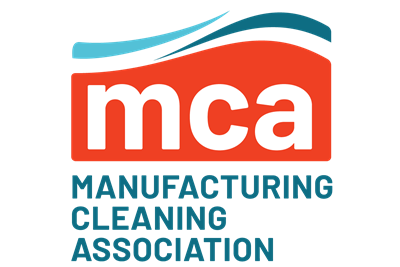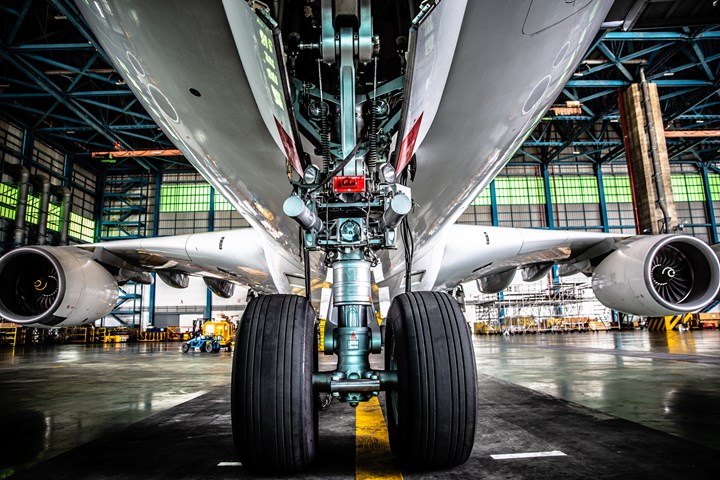
Requirements are a key driver when it comes to selecting a cleaning method.
Photo Credit: Images courtesy of SAFECHEM
What is better for metal cleaning — aqueous or solvent? The answer is: it depends. In fact, the question is rather: what are your requirements, goals and expectations? Both can be effective cleaning methods, depending on the specific context. In order to choose the right cleaning solution, you need to first understand how these two approaches differ in their working.
In aqueous cleaning, water-based detergents emulsify and encapsulate contaminants so they can be washed away. Detergents, surfactants, emulsifiers or buffers are added to the water to facilitate and enhance its cleaning performance for the removal of contaminants. The process can also be aided by heat, agitation and time. Multiple wash stations are followed by rinsing baths to remove any residues. Parts are then dried with heaters or blowers.
Solvents, on the other hand, enable the chemical dissolution of oils and greases in the cleaning solution. Metal parts are immersed in a solvent (or sprayed) that is continuously conditioned through filtration and distillation. Cleaning power can be further improved by mechanics. The parts then undergo vapor cleaning where pure solvent vapor reaches the entire surface including tiny holes, condenses on the cooler parts, thereby removing virtually any residual oil film. The cleaned parts are then removed dry following a (vacuum) drying process.
Environmental responsibility
Whether it is aqueous or solvent cleaning, both cleaning processes require diligence from users in ensuring worker safety, environmental protection and regulatory compliance.
Although water tends to be associated with sustainability or “green,” it is a finite resource. Certain water-based cleaners are also classified as more dangerous than specific solvent cleaners in their toxicological profile. Proper treatment of wastewater is therefore of crucial importance. Even if the water-based cleaners are biodegradable, given that soils generally are not, the wastewater still needs to be treated and disposed of properly.
Since solvents can give off volatile organic compounds (VOCs), the use of modern closed cleaning machines with a built-in distillation unit can significantly reduce air emissions and waste to an absolute minimum (solvent consumption is optimized simultaneously since less solvent is lost to the air and less waste is generated). State-of-the-art vapor degreasers under closed vacuum conditions are engineered to avoid any interface between operator and solvent. The vacuum operation model in closed machines also ensures that flammable solvents are safely handled.
5 key questions to consider in choosing the right cleaning solution
Choosing the right cleaning solution goes beyond meeting the required technical cleanliness. You want to do the job in the most economically viable and safest way while preserving the environment. Making the right decision, therefore, depends on several factors — technical, economic, environmental, health and safety. Some key questions you should consider include:
1. What are your cleaning quality requirements?
Different industrial applications necessitate varying degrees of surface energy of the metal surface, which is influenced by filmy contaminations. With nitriding, for example, a higher surface energy is required than with standard coating or assembling. The required surface energy should therefore match the ability of the cleaning agent.
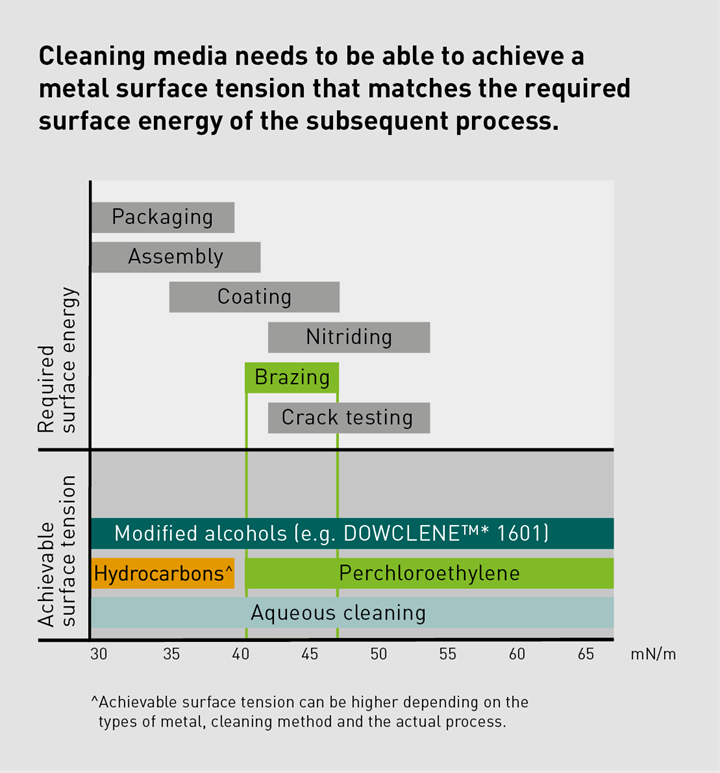
In aqueous cleaning, as soils and contaminations are emulsified and flooded off the surface which remain in the water (unless specific procedures are performed to purify the water), the quality of cleaning will mainly depend on the quality of the rinsing baths, as well as the number of the rinsing baths with demineralized water. The higher the required quality of cleaning, the investment and space requirements for the aqueous systems will increase accordingly.
2. What is the affinity of the cleaning agent to the soils?
Effective cleaning is based on the principle “Equal dissolves equal.” For water-based types of contaminations such as coolant and lubricant emulsions, aqueous cleaning agents are typically the first choice.
When removing mineral oil-based, non-polar contaminations, such as machining oils, greases and waxes, solvent will commonly be the preferred cleaning agent.
Above contaminations can be classified as filmy contaminations, which can be dissolved in a suitable cleaning agent. Another important category of contaminations are particles like chips, dust and residues of polishing pastes. These contaminations cannot be dissolved in a cleaning agent. To remove those, sufficient mechanics are required in the cleaning machine to flush off the particle contaminations.
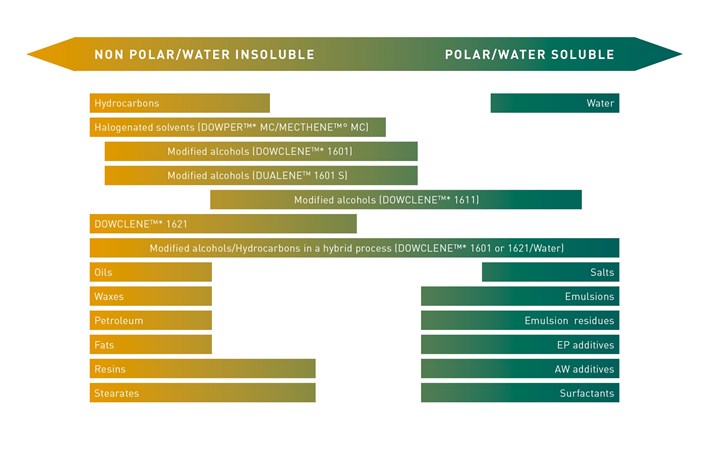
The graphic shows what types of contaminations are best cleaned off by which cleaning agent. To achieve optimal cleaning results, the cleaning agent should be chemically similar to the contaminant.
3. What metal types are you cleaning and how are they configured?
In water-based processes, cleaning agents which can be acidic, neutral or alkaline, are usually matched to specific metal types. Simultaneous cleaning of different metals can therefore be problematic and this can result in compatibility issues and in worst case: corrosion. Solvents in comparison have universal compatibility with metals.
If the component parts are tiny or have complex geometry or small crevices, solvent is often recommended due to its lower surface tension and viscosity which makes it easy to wet into and evaporate out of tight spaces.
4. What is the energy demand in the process?
In water-based cleaning, significant energy is required for pre-treating and heating up cleaning water, operating high-pressure pumps, drying parts as well as treating wastewater.
Solvent vapor degreasing also requires energy to keep the entire operation under vacuum condition. Given that operating temperatures are reduced accordingly in a vacuum, the boiling point of solvent is also reduced, making evaporation quick and effective.
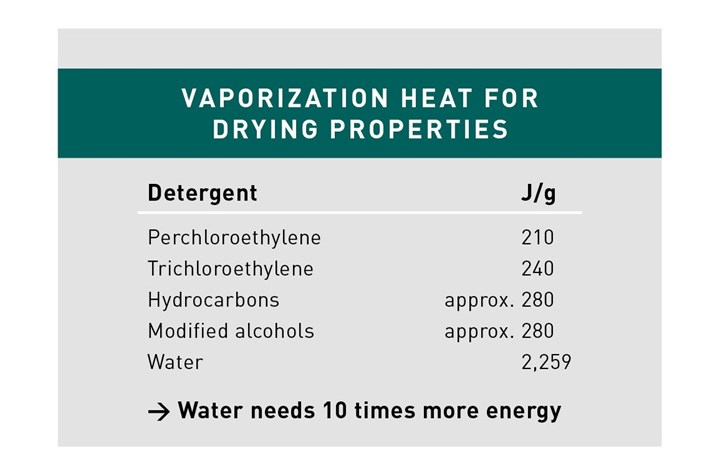
Vapor degreasing systems usually work vertically, compared to aqueous cleaning which often operates horizontally (a typical aqueous batch system may have one wash tank and 2-5 rinse tanks, with the number of rinse tanks depending upon the required cleaning quality). Water-based cleaning, therefore, tends to require more electricity to run.
5. What is the potential for re-use and recycling the cleaning media?
Since dirts and soils are emulsified and rinsed off in aqueous cleaning, aqueous baths that are not treated have to be replaced frequently. Solvent can be recycled again and again via the distillation unit, which is built within the vapor degreasing system or as a separate additional system.
If there is a large amount of oils to be cleaned off, the opportunity to separate solvent from oils (via distillation) can be a particular advantage, since solvent can be effectively recovered, leaving only very little solvent residues in the waste.

The questions listed above are by no means exhaustive, and there are many more aspects to consider. Given that every industrial process is unique within its own specific context, so are the goals and the requirements. The selection of the right cleaning solution demands objective and considered evaluation. Above all else, compatibility and efficiency testing, as well as in-depth consultation with chemicals suppliers and machine manufacturers, will be crucial in helping you reach the right conclusion for your application.
Related Content
Understanding and Managing White Spots on Anodized Aluminum
Having trouble with spotting defects when anodizing? Taj Patel of Techevon LLC offers a helpful overview of the various causes of white spots and potential solutions.
Read MoreAlkaline Cleaning Guide
Gregg Sanko, Senior Chemist, Oakite Products, Inc. provides an overview of the alkaline cleaning process.
Read MoreConveyors and Paint Systems
Choosing the right conveyor system, coating technology, and ancillary equipment.
Read MoreRead Next
Extending Bath Life and Reducing Process Challenges in Vapor Degreasing Systems
How using a stabilizer can extend your bath life and help you avoid costly system repairs.
Read MoreThe Case for Parts Cleaning
Understanding the consequences and costs of not cleaning well.
Read MoreLeading Companies Launch Manufacturing Cleaning Association
Gardner Business Media and other leaders in manufacturing have established the Manufacturing Cleaning Association to establish standards and spread knowledge.
Read More





















